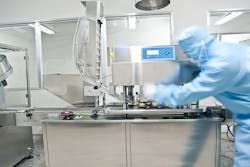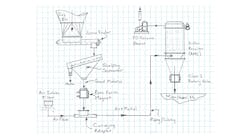When it comes to quality control, statistical process control (SPC) helps manufacturers to maximize production of on-spec product with minimal waste and rework. Attaining and keeping control is a common goal in many industries. And manufacturing is no exception. SPC is a fundamental continuous improvement tool that seeks to monitor and control processes by identifying problem areas, limiting variation and optimizing processes. By gathering information about the various stages of the process and performing statistical analysis on that information, engineers can ensure that the overall process stays in control, meeting all desired specifications.
Clean rooms are commonly used in manufacturing processes in the pharmaceutical, semiconductor, aerospace, optics and biological safety segments. To make the best use of statistical process control for clean room quality control, the troubleshooting team should always be ready to think outside the box or farther down the production line. Airborne particulates are a common problem affecting product quality, but their sources are often far from the points of contamination. Particles can be blown long distances from the source because of eddy currents and other phenomena that occur around devices. Vibration can also cause product contamination, and its source can sometimes be distant from the process line. In all these cases, SPC systems aid in detecting potentially harmful influences on production and quality control.
Contamination sources
It is best to begin by creating a checklist of behavior and properties to be expected from a clean space. What are likely contamination sources? Check the obvious symptoms first, such as air flows and laminarities. Only after ruling out problems that can be easily fixed should the team move on to more sophisticated tests, which are also more expensive and time consuming. So, for example, when scanning filters, start at the top and work down from the ceiling.
In one case, the suspected source of product contamination was a manufacturing tool. Using SPC data, engineers discovered an upward trend in particles following a period of relatively flat activity over a typical window of time. When the indicator started to increase, which led to further investigation, a contamination source was detected. Operators then realized the ionization emitter had not only failed but was also the producer of the errant particles. The older emitter was made out of an ion-based metal that releases positively and negatively charged particles.
In another case of contamination at a distance, a particle source was reported to be a light station. Instead, the actual source was found at a point 15 feet farther down the bay. Engineers discovered that the laminar flow in the space was not parallel by setting up laminar strips — light, fuzzy wool thread — on a trolley car, lining it up so that the end of the strip was at the particle counter. They moved the station until the end of the strip hit the particle counter, detecting that airflow was coming from somewhere else. This affected airflow, causing the particles to travel down the side of the wall and fall out at the light station.
It is often helpful to understand each phase in the maintenance cycle of a piece of equipment to track down the source of the problem. In another facility, that source was originally believed to be the tool itself. But testing confirmed that the tool was still contaminated with particles even after it was thoroughly cleaned. It was determined, using SPC, that electrical motors outside of the tool were running when operators opened the tool to clean it. Engineers knew from experience that motors can be a contaminant source. The answers that they got from operators revealed both that the tool was located beneath the motor housing and that the motor in that housing was running during the cleaning process. Multiple tools had been set up this way, but further questioning revealed that this was the one that operators could not get clean. Testing the area with a particle counter confirmed significant levels of particles. Operators were asked to turn off the motor during cleaning, and the result was a spotless tool. The motor was examined and found to be failing, which produced particles that fell into the tool during cleaning. The problem was solved by replacing the motor.
Understandably, most operators don’t think of a motor as a source of contamination. But if a motor’s bearings fail, it can emit a thousand times more particles than it normally would. Anything that is moving could reach a state where metal is scraping on metal, such as when a door on a hydraulic ram got off its track and was scraping the frame. Metallurgical tests can reveal what type of metal is in the contamination — for example, aluminum, stainless, steel, cast iron — and these results can be used to narrow the search.
Causes of vibration
Is vibration most likely to originate on the same level where its distorting effects are detected? Not always. When operators in another facility identified a vibration source in a tool they were qualifying, they proceeded logically by rebalancing the tool and replacing the air bearings. And yet the vibration persisted. Since the facility operators’ jurisdiction ended at the tool level, engineers were needed to look beyond, tracing the source of the vibration to a point three stories below the tool. They found a piece of strut channel from the frame of a pump set had been attached to a column to hang an instrument. That pump set was transmitting vibration through the strut channel to the column, which was beneath the base of the tool unit. The tool unit itself was not the vibration source.
Qualifying tools for production may involve working through SPC systems and making changes to determine if there are any increases or decreases in levels. Yet another challenge to the diagnostic process is often easily overlooked: Sources completely outside the facility. In one such case, engineers analyzed SPC data to find no vibration sources inside the building. After a complicated two-year analysis process within the facility, they decided to move their efforts outside. They eventually noticed that the time stamp of the vibration coincided with the scheduled passage of a train approximately 400 feet away. Under the direction of the project team, a test performed with a vibration monitor confirmed that the movement of the train was the source of the vibration. And the effect was even more specific: it happened only when the train was carrying a full load in one direction. Based on this discovery, the facility layout was modified to counter the effect.
Another likely contributor to intrusive vibration may simply be a change in the settings of a previously non-intrusive component. This was the case for a pump that operated for a year with no vibration issues. When its speed was doubled to carry a higher volume of water, vibration started that affected the entire building. Part of the vibration occurred when the water slammed into an elbow in the pipe. The team had to retrofit the system by disconnecting all the pump supports from the building and adding a stand-alone support system.
When vibration is the problem, eliminate one potential source at a time and then follow the chain of suspected sources further down the line. It helps to understand vibration characteristics and harmonics. Based on the frequencies transmitted, certain sources can be ruled out. For example, mechanical sources produce lower frequencies, whereas whistling sources are associated with higher frequencies. It may be necessary to hire a firm with expertise in vibration troubleshooting. As the foregoing examples show, it is always smart to maintain a wide-angle lens on the area that is experiencing such issues as contamination and vibration.
Dewayne Galyon is a Basebuild Technical Specialist with SSOE Group, a global project delivery firm for architecture, engineering and construction management. He has more than 25 years of experience in process engineering and engineering management. Galyon may be reached in SSOE’s Hillsboro, Oregon office at [email protected] or 503 213-4250.


